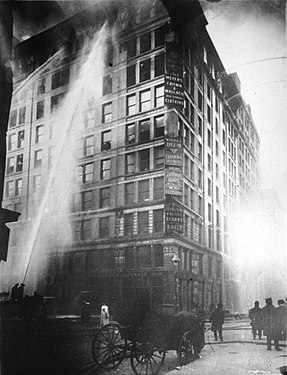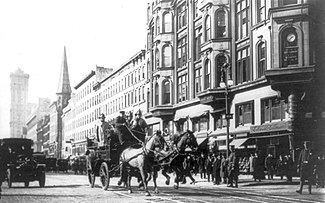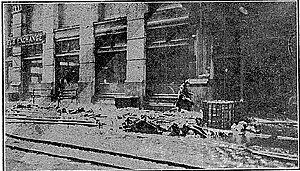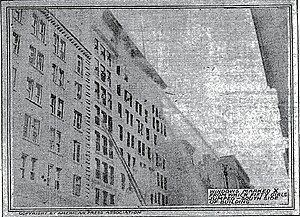Triangle Shirtwaist Factory Catches on Fire (1911): On March 25, 1911, a fire broke out on the eighth floor of the Triangle Waist Company's factory in New York City. The fire spread quickly. Of the approximately 500 workers, 146 died. This was the worst Industrial accident in the USA at that time.
Overview of the Triangle Shirtwaist Factory Fire:
The Triangle Waist Company was owned by Max Blanck and Isaac Harris. Both men had emigrated from Russia as young men, met in the United States, and by 1900 had a little shop together on Woodster Street they named the Triangle Waist Company. Growing quickly, they moved their business into the ninth floor of the new, ten-story Asch Building, on the corner of Washington Place and Greene Street in New York City. They later expanded into the eighth floor and then the tenth floor.
By 1911, the Triangle Waist Company was one of the largest blouse makers in New York City. They specialized in making shirtwaists, the very popular women's blouse that had a tight waist and puffy sleeves. The Triangle Waist Company had made Blanck and Harris rich, but it was through the exploitation of their workers.
Approximately 500 people, mostly immigrant women, worked at the Triangle Waist Company's factory in the Asch Building. They worked long hours, six days a week, in cramped quarters and were paid low wages. Many of the workers were young, some only age 13 or 14.
In 1909, shirtwaist factory workers from around the city went on strike for an increase in pay, shorter work week, and the recognition of a union. Though many of the other shirtwaist companies eventually agreed to the strikers' demands, the Triangle Waist Company owners never did. Conditions at the Triangle Waist Company factory remained poor.
On Saturday, March 25, 1911, a fire started on the eighth floor. Work had ended at 4:30 that day and most of the workers were gathering their belongings and their paychecks when a cutter noticed a small fire had started in his scrap bin. No one is sure what exactly started the fire, but a fire marshal thought a cigarette butt had possibly gotten tossed into the bin. Nearly everything in the room was flammable: hundreds of pounds of cotton scraps, tissue paper patterns, and wooden tables.
Several workers threw pails of water on the fire, but it quickly grew out of control. Workers then tried to use the fire hoses that were available on each floor, for one last attempt to put out the fire; however, when they turned the water valve on, no water came out.
A woman on the eighth floor tried to call the ninth and tenth floors to warn them. Only the tenth floor received the message; those on the ninth floor didn't know about the fire until it was upon them.
Everyone rushed to escape the fire. Some ran to the four elevators. Built to carry a maximum of 15 people each, they quickly filled with 30. There wasn't time for many trips to the bottom and back up before the fire reached the elevator shafts as well. Others ran to the fire escape. Though about 20 reached the bottom successfully, about 25 others died when the fire escape buckled and collapsed.
Many on the tenth floor, including Blanck and Harris, made it safely to the roof and then were helped to nearby buildings. Many on the eighth and ninth floors were stuck. The elevators were no longer available, the fire escape had collapsed, and the doors to the hallways were locked (company policy). Many workers headed to the windows.
At 4:45 p.m., the fire department was alerted to the fire. They rushed to the scene, raised their ladder, but it only reached to the sixth floor. Those on the window ledges started jumping.
The fire was put out in half an hour, but it was not soon enough. Of the 500 employees, 146 were dead. The bodies were taken to a covered pier on Twenty-Sixth Street, near the East River. Thousands of people lined up to identify the bodies of loved ones. After a week, all but seven were identified.
Many people searched for someone to blame. The Triangle Waist Company owners, Blanck and Harris, were tried for manslaughter, but were found not guilty.
The fire and the large number of deaths exposed the hazardous conditions and fire danger that was ubiquitous in these high-rise factories. Shortly after the Triangle fire, New York City passed a large number of fire, safety, and building codes and created stiff penalties for non-compliance. Other cities followed New York's example.
 | |
| Date | March 25, 1911 |
|---|---|
| Time | 4:40 PM (local time) |
| Location | Manhattan, New York City, U.S. |
| Casualties | |
| 146 dead | |
| 71 injured | |
The Triangle Shirtwaist Factory fire in New York City on March 25, 1911, was the deadliest industrial disaster in the history of the city of New York and resulted in the fourth highest loss of life from an industrial accident in U.S. history. It was also the second deadliest disaster in New York City – after the burning of the General Slocum on June 15, 1904 – until the destruction of the World Trade Center 90 years later.






No comments:
Post a Comment